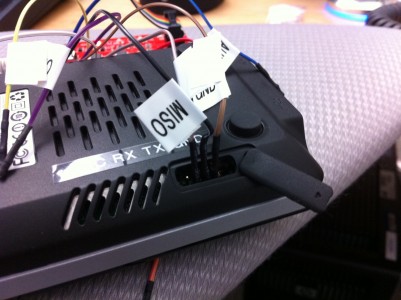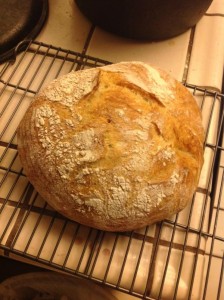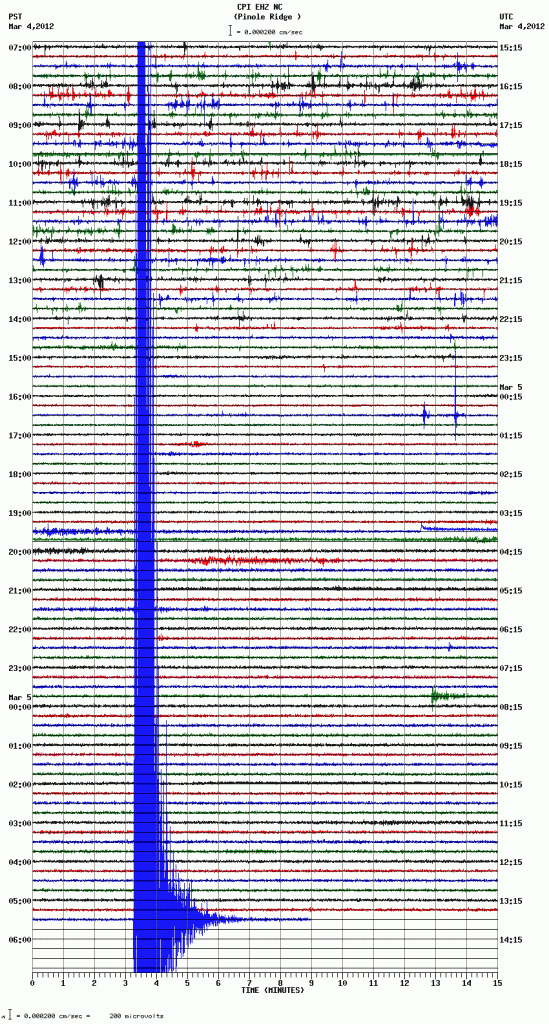A few days ago, I mentioned that one of my servers had died. I spent some time thinking about how I would replace it. I like having a 24/7 hooked up to the Internet to serve as a file drop and a place where I can use SSH to connect to other devices on my home network, but the machine need not be hugely fast, and it would probably be better if it were fairly low power. My previous server drew about 30 watts, and I suspected that I could get something more compact and lower power to replace it.
So, I ordered a TonidoPlug 2. It’s a cute little server based upon the Sheeva Plug computer concept, but includes space to insert a 2.5″ SATA laptop drive. It has all sorts of “personal cloud” applications running on it, which I had no interest in, but doing a bit more research, I found that I could install ArchLinux on the internal hard drive, and it would boot to that automatically. Cool, think I. I ordered mine off Amazon.
It arrived yesterday. I powered it up, verified that it worked in its default configuration, then proceeded to follow the directions on the ArchLinux ARM page. Upon reboot… not good. I ended up with a flashing red LED, and the network never comes back up. So, I pulled the internal drive, and it reboots back to its default configuration.
I then start tracking through various support and Wiki links. I find that some people have had difficulty booting from the internal drives, and the Tonido support guys have been very coy, claiming that “we don’t support that”. Frown. Not good.
 But in doing this research, I found that it was possible to access the boot loader and serial console. On the bottom side of the tonido is a nice little rubber cover, concealing 4 pins. Most people seem to make a small adapter to use an FTDI-serial adapter cable with it (the six pin ones like you would use for the Arduino), but I had a Bus Pirate sitting around, and I thought that it might work. And… it did!
But in doing this research, I found that it was possible to access the boot loader and serial console. On the bottom side of the tonido is a nice little rubber cover, concealing 4 pins. Most people seem to make a small adapter to use an FTDI-serial adapter cable with it (the six pin ones like you would use for the Arduino), but I had a Bus Pirate sitting around, and I thought that it might work. And… it did!
In case anyone else (or me in the future) wants to know how to do this:
- The four pins are Vcc, Rx, Tx, and GND, starting from the power supply side and working toward the USB/Ethernet cable side.
- I just hooked up MOSI to RX, MISO to TX, and GND to GND
- To use the Bus Pirate with my Mac laptop, I like to use GNU screen. If you run “screen /dev/tty.usbserial-AH00MPIK 115200” (your tty device will likely be different), it makes a convenient terminal emulator. From there, you can access the Bus Pirate, configure it in UART mode with a baud rate of 115200 and sensible other defaults.
- You can then use the Bus Pirate as a UART bridge by invoking the “(1)” macro. You’ll then essentially be talking directly to the Tonido via the BusPirate.
- Using screen’s C-a H command, you can start a log file, which will record all the output from the serial port. Doing the command again will stop logging.
Hooking it up, I got lots of cool info from the Tonido:
__ __ _ _
| \/ | __ _ _ ____ _____| | |
| |\/| |/ _` | '__\ \ / / _ \ | |
| | | | (_| | | \ V / __/ | |
|_| |_|\__,_|_| \_/ \___|_|_|
_ _ ____ _
| | | | | __ ) ___ ___ | |_
| | | |___| _ \ / _ \ / _ \| __|
| |_| |___| |_) | (_) | (_) | |_
\___/ |____/ \___/ \___/ \__|
** MARVELL BOARD: DB-88F6282A-BP LE
U-Boot 1.1.4 (Sep 13 2011 - 13:25:05) Marvell version: 3.4.27
USISH-SMB Ver: topkick1281p2-001-008-20110913-codelathe
U-Boot code: 00600000 -> 0067FFF0 BSS: -> 006D0120
Soc: MV88F1155 Rev 1 (DDR2)
CPU running @ 800Mhz L2 running @ 400Mhz
SysClock = 400Mhz , TClock = 200Mhz
DRAM unknown CAL tRP = 8 tRAS = 20 tRCD=8
DRAM CS[0] base 0x00000000 size 512MB
DRAM Total size 512MB 16bit width
Addresses 8M - 0M are saved for the U-Boot usage.
Mem malloc Initialization (8M - 7M): Done
NAND:512 MB
Flash: 0 kB
CPU : Marvell Feroceon (Rev 1)
Streaming disabled
Write allocate disabled
USB 0: host mode
PEX 0: interface detected no Link.
Net: egiga0 [PRIME]
Hit any key to stop autoboot: 0
(Re)start USB...
USB: scanning bus for devices... 1 USB Device(s) found
Waiting for storage device(s) to settle before scanning...
0 Storage Device(s) found
** Bad partition 1 **
## Booting image at 00800000 ...
Bad Magic Number
Saving Environment to NAND...
Erasing Nand...Writing to Nand... done
Reset IDE:
Marvell Serial ATA Adapter
Integrated Sata device found
[0 0 0]: Enable DMA mode (5)
Device 0 @ 0 0:
Model: TOSHIBA MK6465GSX Firm: GJ003M Ser#: 50OAC319T
Type: Hard Disk
Supports 48-bit addressing
Capacity: 610480.3 MB = 596.1 GB (1250263728 x 512)
** Unable to read "/boot/uImage" from ide 0:1 **
## Booting image at 00800000 ...
Bad Magic Number
Saving Environment to NAND...
Erasing Nand...Writing to Nand... done
NAND read: device 0 offset 0x200000, size 0x600000
6291456 bytes read: OK
## Booting image at 01200000 ...
Image Name: Linux-2.6.31.8-topkick1281p2-001
Created: 2011-11-10 3:58:11 UTC
Image Type: ARM Linux Kernel Image (uncompressed)
Data Size: 3121408 Bytes = 3 MB
Load Address: 00008000
Entry Point: 00008000
Verifying Checksum ... OK
OK
Starting kernel ...
Uncompressing Linux................................................................................................................................................................................................... done, booting the kernel.
Linux version 2.6.31.8-topkick1281p2-001-004-20101214 (andrew@localhost.localdomain) (gcc version 3.4.4 (release) (CodeSourcery ARM 2005q3-2)) #2 Thu Nov 10 11:58:07 CST 2011
CPU: Feroceon 88FR131 [56251311] revision 1 (ARMv5TE), cr=00053977
CPU: VIVT data cache, VIVT instruction cache
Machine: Feroceon-KW
Using UBoot passing parameters structure
Memory policy: ECC disabled, Data cache writeback
Built 1 zonelists in Zone order, mobility grouping on. Total pages: 130048
Kernel command line: console=ttyS0,115200;version=topkick1281p2-001-006-20101103 mtdparts=nand_mtd:0x180000@0(u-boot),0x20000@0x180000(u-boot-env),0x600000@0x200000(uImage),0x1f800000@0x800000(rootfs) ubi.mtd=3 root=ubi0:rootfs rootfstype=ubifs rootdelay=10
PID hash table entries: 2048 (order: 11, 8192 bytes)
Dentry cache hash table entries: 65536 (order: 6, 262144 bytes)
Inode-cache hash table entries: 32768 (order: 5, 131072 bytes)
Memory: 512MB = 512MB total
Memory: 513280KB available (5612K code, 319K data, 148K init, 0K highmem)
NR_IRQS:128
Console: colour dummy device 80x30
Calibrating delay loop... 794.62 BogoMIPS (lpj=3973120)
Mount-cache hash table entries: 512
CPU: Testing write buffer coherency: ok
xor: measuring software checksum speed
arm4regs : 723.200 MB/sec
8regs : 433.600 MB/sec
32regs : 600.800 MB/sec
xor: using function: arm4regs (723.200 MB/sec)
NET: Registered protocol family 16
Feroceon L2: Enabling L2
Feroceon L2: Cache support initialised.
CPU Interface
-------------
SDRAM_CS0 ....base 00000000, size 512MB
SDRAM_CS1 ....disable
SDRAM_CS2 ....disable
SDRAM_CS3 ....disable
PEX0_MEM ....base e8000000, size 128MB
PEX0_IO ....base f2000000, size 1MB
INTER_REGS ....base f1000000, size 1MB
NFLASH_CS ....base fa000000, size 2MB
SPI_CS ....base f4000000, size 16MB
BOOT_ROM_CS ....no such
DEV_BOOTCS ....no such
CRYPT_ENG ....base f0000000, size 2MB
Marvell Development Board (LSP Version KW_LSP_5.0.3)-- DB-88F6282A-BP Soc: MV88F1155 Rev 1 LE
Detected Tclk 200000000 and SysClk 400000000
MV Buttons Device Load
Marvell USB EHCI Host controller #0: df837740
PEX0 interface detected no Link.
PCI: bus0: Fast back to back transfers enabled
bio: create slab <bio-0> at 0
SCSI subsystem initialized
usbcore: registered new interface driver usbfs
usbcore: registered new interface driver hub
usbcore: registered new device driver usb
raid6: int32x1 72 MB/s
raid6: int32x2 101 MB/s
raid6: int32x4 88 MB/s
raid6: int32x8 80 MB/s
raid6: using algorithm int32x2 (101 MB/s)
cfg80211: Calling CRDA to update world regulatory domain
NET: Registered protocol family 2
IP route cache hash table entries: 16384 (order: 4, 65536 bytes)
TCP established hash table entries: 65536 (order: 7, 524288 bytes)
TCP bind hash table entries: 65536 (order: 6, 262144 bytes)
TCP: Hash tables configured (established 65536 bind 65536)
TCP reno registered
NET: Registered protocol family 1
rtc mv_rtc: rtc core: registered kw-rtc as rtc0
RTC registered
cpufreq: Init kirkwood cpufreq driver
XOR registered 4 channels
XOR 2nd invalidate WA enabled
mvCesaInit: sessions=640, queue=64, pSram=f0000000
Warning: TS unit is powered off.
MV Buttons Driver Load
JFFS2 version 2.2. (NAND) © 2001-2006 Red Hat, Inc.
SGI XFS with security attributes, large block/inode numbers, no debug enabled
msgmni has been set to 1002
alg: No test for cipher_null (cipher_null-generic)
alg: No test for ecb(cipher_null) (ecb-cipher_null)
alg: No test for digest_null (digest_null-generic)
alg: No test for compress_null (compress_null-generic)
alg: No test for stdrng (krng)
alg: No test for hmac(digest_null) (hmac(digest_null-generic))
async_tx: api initialized (sync-only)
io scheduler noop registered
io scheduler anticipatory registered (default)
Serial: 8250/16550 driver, 4 ports, IRQ sharing disabled
serial8250.0: ttyS0 at MMIO 0xf1012000 (irq = 33) is a 16550A
console [ttyS0] enabled
Integrated Sata device found
IRQ 21/mvSata: IRQF_DISABLED is not guaranteed on shared IRQs
scsi0 : Marvell SCSI to SATA adapter
scsi1 : Marvell SCSI to SATA adapter
scsi 0:0:0:0: Direct-Access TOSHIBA MK6465GSX GJ00 PQ: 0 ANSI: 5
sd 0:0:0:0: [sda] Sector size 0 reported, assuming 512.
sd 0:0:0:0: [sda] 1250263728 512-byte logical blocks: (640 GB/596 GiB)
sd 0:0:0:0: [sda] 0-byte physical blocks
sd 0:0:0:0: [sda] Write Protect is off
sd 0:0:0:0: Attached scsi generic sg0 type 0
Loading Marvell Ethernet Driver:
o Cached descriptors in DRAM
o DRAM SW cache-coherency
o 2 Giga ports supported
o Multi RX Queue support - 4 RX queues
o Multi TX Queue support - 2 TX Queues
o TCP segmentation offload (TSO) supported
o Large Receive offload (LRO) supported
o Receive checksum offload supported
o Transmit checksum offload supported
o Network Fast Processing (Routing) supported - (Disabled)
o Network Fast Processing (NAT) supported
o Driver ERROR statistics enabled
o Driver INFO statistics enabled
o Proc tool API enabled
o SKB Reuse supported - (Disabled)
o SKB Recycle supported - (Disabled)
o Gateway support enabled
o Using Marvell Header Mode
o L2 IGMP support
o Rx descripors: q0=128 q1=128 q2=128 q3=128
o Tx descripors: q0=532 q1=532
o Loading network interface(s):
o register under mv88fx_eth platform
sd 0:0:0:0: [sda] Write cache: enabled, read cache: enabled, supports DPO and FUA
sd 0:0:0:0: [sda] Sector size 0 reported, assuming 512.
o eth0, ifindex = 2, GbE port = 0
Warning: Giga 1 is Powered Off
Warning: Giga 1 is Powered Off
mvFpRuleDb (df280000): 16384 entries, 65536 bytes
Intel(R) PRO/1000 Network Driver - version 7.3.21-k3-NAPI
Copyright (c) 1999-2006 Intel Corporation.
e1000e: Intel(R) PRO/1000 Network Driver - 1.0.2-k2
e1000e: Copyright (c) 1999-2008 Intel Corporation.
e100: Intel(R) PRO/100 Network Driver, 3.5.24-k2-NAPI
e100: Copyright(c) 1999-2006 Intel Corporation
sda:
PPP generic driver version 2.4.2
PPP Deflate Compression module registered
PPP BSD Compression module registered
PPP MPPE Compression module registered
NET: Registered protocol family 24
PPPoL2TP kernel driver, V1.0
Using Hamming 1-bit ECC for NAND device
NAND device: Manufacturer ID: 0xad, Chip ID: 0xdc (Hynix NAND 512MiB 3,3V 8-bit)
Scanning device for bad blocks
Bad eraseblock 1064 at 0x000008500000
Bad eraseblock 1065 at 0x000008520000
Bad eraseblock 1884 at 0x00000eb80000
Bad eraseblock 1885 at 0x00000eba0000
Bad eraseblock 2038 at 0x00000fec0000
Bad eraseblock 2039 at 0x00000fee0000
Bad eraseblock 2580 at 0x000014280000
Bad eraseblock 2581 at 0x0000142a0000
Bad eraseblock 2606 at 0x0000145c0000
Bad eraseblock 2844 at 0x000016380000
Bad eraseblock 3269 at 0x0000198a0000
Bad eraseblock 3547 at 0x00001bb60000
4 cmdlinepart partitions found on MTD device nand_mtd
Using command line partition definition
Creating 4 MTD partitions on "nand_mtd":
0x000000000000-0x000000180000 : "u-boot"
sda1
sd 0:0:0:0: [sda] Sector size 0 reported, assuming 512.
0x000000180000-0x0000001a0000 : "u-boot-env"
sd 0:0:0:0: [sda] Attached SCSI disk
0x000000200000-0x000000800000 : "uImage"
0x000000800000-0x000020000000 : "rootfs"
UBI: attaching mtd3 to ubi0
UBI: physical eraseblock size: 131072 bytes (128 KiB)
UBI: logical eraseblock size: 129024 bytes
UBI: smallest flash I/O unit: 2048
UBI: sub-page size: 512
UBI: VID header offset: 512 (aligned 512)
UBI: data offset: 2048
UBI: attached mtd3 to ubi0
UBI: MTD device name: "rootfs"
UBI: MTD device size: 504 MiB
UBI: number of good PEBs: 4020
UBI: number of bad PEBs: 12
UBI: max. allowed volumes: 128
UBI: wear-leveling threshold: 4096
UBI: number of internal volumes: 1
UBI: number of user volumes: 1
UBI: available PEBs: 75
UBI: total number of reserved PEBs: 3945
UBI: number of PEBs reserved for bad PEB handling: 40
UBI: max/mean erase counter: 3/1
UBI: image sequence number: 0
ehci_hcd: USB 2.0 'Enhanced' Host Controller (EHCI) Driver
ehci_marvell ehci_marvell.70059: Marvell Orion EHCI
ehci_marvell ehci_marvell.70059: new USB bus registered, assigned bus number 1
UBI: background thread "ubi_bgt0d" started, PID 480
ehci_marvell ehci_marvell.70059: irq 19, io base 0xf1050100
ehci_marvell ehci_marvell.70059: USB 2.0 started, EHCI 1.00
usb usb1: configuration #1 chosen from 1 choice
hub 1-0:1.0: USB hub found
hub 1-0:1.0: 1 port detected
ohci_hcd: USB 1.1 'Open' Host Controller (OHCI) Driver
uhci_hcd: USB Universal Host Controller Interface driver
usbcore: registered new interface driver usblp
Initializing USB Mass Storage driver...
usbcore: registered new interface driver usb-storage
USB Mass Storage support registered.
usbcore: registered new interface driver ums-datafab
usbcore: registered new interface driver ums-freecom
usbcore: registered new interface driver ums-jumpshot
usbcore: registered new interface driver ums-sddr09
usbcore: registered new interface driver ums-sddr55
usbcore: registered new interface driver ums-usbat
pwrctl: dev_t_NO. = 0xdd00000, major = 221
pwrctl: request the irq power off registered.
mice: PS/2 mouse device common for all mice
i2c /dev entries driver
Linux telephony interface: v1.00
md: linear personality registered for level -1
md: raid0 personality registered for level 0
md: raid1 personality registered for level 1
md: raid6 personality registered for level 6
md: raid5 personality registered for level 5
md: raid4 personality registered for level 4
device-mapper: ioctl: 4.15.0-ioctl (2009-04-01) initialised: dm-devel@redhat.com
sdhci: Secure Digital Host Controller Interface driver
sdhci: Copyright(c) Pierre Ossman
mmc0: mvsdio driver initialized, lacking card detect (fall back to polling)
Advanced Linux Sound Architecture Driver Version 1.0.20.
No device for DAI CS42L51
ALSA device list:
No soundcards found.
nf_conntrack version 0.5.0 (8192 buckets, 32768 max)
mvFpNatDb (df360000): 16384 entries, 65536 bytes
ip_tables: (C) 2000-2006 Netfilter Core Team
TCP cubic registered
NET: Registered protocol family 17
NFP (fdb) init 256 entries, 1024 bytes
RPC: Registered udp transport module.
RPC: Registered tcp transport module.
802.1Q VLAN Support v1.8 Ben Greear <greearb@candelatech.com>
All bugs added by David S. Miller <davem@redhat.com>
rtc mv_rtc: setting system clock to 2012-03-31 01:20:22 UTC (1333156822)
Waiting 10sec before mounting root device...
mmc0: new high speed SDIO card at address 0001
md: Waiting for all devices to be available before autodetect
md: If you don't use raid, use raid=noautodetect
md: Autodetecting RAID arrays.
md: Scanned 0 and added 0 devices.
md: autorun ...
md: ... autorun DONE.
UBIFS: mounted UBI device 0, volume 0, name "rootfs"
UBIFS: file system size: 501387264 bytes (489636 KiB, 478 MiB, 3886 LEBs)
UBIFS: journal size: 25159680 bytes (24570 KiB, 23 MiB, 195 LEBs)
UBIFS: media format: w4/r0 (latest is w4/r0)
UBIFS: default compressor: lzo
UBIFS: reserved for root: 4952683 bytes (4836 KiB)
VFS: Mounted root (ubifs filesystem) on device 0:11.
Freeing init memory: 148K
Using makefile-style concurrent boot in runlevel S.
Starting the hotplug events dispatcher: udevd.
Synthesizing the initial hotplug events...done.
Waiting for /dev to be fully populated...done.
Setting parameters of disc: (none).
Activating swap...done.
Starting early crypto disks...done.
Starting remaining crypto disks...done.
Loading kernel modules...done.
Cleaning up ifupdown....
Setting up networking....
Activating lvm and md swap...done.
Checking file systems...fsck from util-linux-ng 2.17.2
done.
Mounting local filesystems...done.
Activating swapfile swap...done.
Cleaning up temporary files....
Setting kernel variables ...done.
Configuring network interfaces...Internet Systems Consortium DHCP Client 4.1.1-P1
Copyright 2004-2010 Internet Systems Consortium.
All rights reserved.
For info, please visit https://www.isc.org/software/dhcp/
eth0: started
Listening on LPF/eth0/40:2c:f4:bc:8b:c9
Sending on LPF/eth0/40:2c:f4:bc:8b:c9
Sending on Socket/fallback
DHCPDISCOVER on eth0 to 255.255.255.255 port 67 interval 4
DHCPDISCOVER on eth0 to 255.255.255.255 port 67 interval 5
DHCPDISCOVER on eth0 to 255.255.255.255 port 67 interval 13
DHCPDISCOVER on eth0 to 255.255.255.255 port 67 interval 10
DHCPDISCOVER on eth0 to 255.255.255.255 port 67 interval 14
DHCPDISCOVER on eth0 to 255.255.255.255 port 67 interval 8
DHCPDISCOVER on eth0 to 255.255.255.255 port 67 interval 7
No DHCPOFFERS received.
No working leases in persistent database - sleeping.
done.
Cleaning up temporary files....
fuse init (API version 7.12)
Using makefile-style concurrent boot in runlevel 2.
Network Interface Plugging Daemon...start eth0...done.
Starting enhanced syslogd: rsyslogd.
Starting Samba daemons: nmbd smbdStarting periodic command scheduler: cron.
.
Starting system message bus: dbus.
Starting OpenBSD Secure Shell server: sshd.
EXT2-fs warning: mounting unchecked fs, running e2fsck is recommended
Debian GNU/Linux 6.0 TonidoPlug2 ttyS0
TonidoPlug2 login: --2012-03-30 18:21:50-- http://patch.codelathe.com/firmware/tonidoplug2/updates.list
Resolving patch.codelathe.com... failed: Name or service not known.
wget: unable to resolve host address “patch.codelathe.com”
Debian GNU/Linux 6.0 TonidoPlug2 ttyS0
TonidoPlug2 login: root
Password:
Last login: Fri Mar 30 18:16:16 PDT 2012 on ttyS0
Linux TonidoPlug2 2.6.31.8-topkick1281p2-001-004-20101214 #2 Thu Nov 10 11:58:07 CST 2011 armv5tel
The programs included with the Debian GNU/Linux system are free software;
the exact distribution terms for each program are described in the
individual files in /usr/share/doc/*/copyright.
Debian GNU/Linux comes with ABSOLUTELY NO WARRANTY, to the extent
permitted by applicable law.
root@TonidoPlug2:~#
I suspect I’ll be able to debug it a lot better tomorrow.


